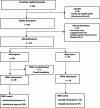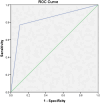Validity of the Nepali Ask Suicide Screening Questions tool for medical inpatients
- PMID: 40696306
- PMCID: PMC12281993
- DOI: 10.1186/s12888-025-07148-w
Validity of the Nepali Ask Suicide Screening Questions tool for medical inpatients
Abstract
Background: Nepal has one of the highest youth suicide rates in the world. Suicide screening is rarely performed during hospitalization, partly due to the lack of validated tools in the local language. We evaluated the validity of the Nepali version of the Ask Suicide-Screening Questions (ASQ) tool in youth population in medical inpatient settings.
Methods: We conducted a cross-sectional validation study at two urban hospitals in Nepal between January and July 2022. Patients aged 10 to 24 years admitted to medical wards were recruited through convenience sampling. Patients with significant cognitive impairment, non-fluent in Nepali, or planned early discharge limiting participation were excluded. Trained nurses administered the ASQ followed by the adolescent version of Patient Health Questionnaire (PHQ - 9) and completed a demographic survey. Thereafter a separate team of psychologists, blind to ASQ results, conducted a brief suicide safety assessment (BSSA) as the gold standard for suicide risk screening.
Results: All study procedures were completed by 309 [54.0% male, mean age = 15.79(± 4.2) years] participants and were included in analysis. In our sample, 15.9% (49/309) screened positive with ASQ; 8.4% (26/309) had elevated suicide risk on the BSSA. The ASQ demonstrated good sensitivity (77%; 95% CI: 56-91), specificity (90%; 95% CI: 86-93), positive predictive value (41%; 95% CI: 27-56) and negative predictive value (98%; 95% CI: 95-99) against BSSA.
Conclusion: The Nepali version of ASQ is a good, brief screening tool for identifying suicidal risk. Further validation in wider populations including outpatient setting and routine implementation in clinical practice should be considered.
Keywords: Ask Suicide-Screening questions; Mental health; Nepal; Suicide; Validation; Youth.
© 2025. The Author(s).
Conflict of interest statement
Declarations. Ethics approval and consent to participate: Informed consent was taken from all participants prior to data collection. Participants were provided with information regarding the purpose of the study, the voluntary nature of the participation, confidentiality of their responses and their right to withdraw at any time without any consequences. The study was approved by ethics committees of Nepal Health Research council [261–2021], Institute of Medicine (Tribhuvan University– IRC,436(6–11) E2 077/078) and Kanti Children’s Hospital (KCH– IRC,1181) as well as the American Academy of Pediatrics IRB (21 PA 01) and all study procedures were completed by full adherence to ethical guidelines and regulations as per Declaration of Helsinki. Consent for publication: Not Applicable. Competing interests: The authors declare no competing interests.
Figures
Similar articles
-
Evaluation of the Ask Suicide-Screening Questions (ASQ) tool, Item 9 of the Patient Health Questionnaire (PHQ), pain, and opioid screening to detect suicide risk among rural adult primary care patients.J Rural Health. 2025 Jun;41(3):e70064. doi: 10.1111/jrh.70064. J Rural Health. 2025. PMID: 40746258
-
A New Measure of Quantified Social Health Is Associated With Levels of Discomfort, Capability, and Mental and General Health Among Patients Seeking Musculoskeletal Specialty Care.Clin Orthop Relat Res. 2025 Apr 1;483(4):647-663. doi: 10.1097/CORR.0000000000003394. Epub 2025 Feb 5. Clin Orthop Relat Res. 2025. PMID: 39915110
-
Single Question for Screening Suicide Risk in Patients With Cancer in Nursing Routine Work: A Retrospective Cross-Sectional Study.J Adv Nurs. 2025 Aug;81(8):4627-4643. doi: 10.1111/jan.16591. Epub 2024 Oct 30. J Adv Nurs. 2025. PMID: 39474782
-
Factors within the clinical encounter that impact upon risk assessment within child and adolescent mental health services: a rapid realist synthesis.Health Soc Care Deliv Res. 2024 Jan;12(1):1-107. doi: 10.3310/VKTY5822. Health Soc Care Deliv Res. 2024. PMID: 38314750
-
Prevention of self-harm and suicide in young people up to the age of 25 in education settings.Cochrane Database Syst Rev. 2024 Dec 20;12(12):CD013844. doi: 10.1002/14651858.CD013844.pub2. Cochrane Database Syst Rev. 2024. PMID: 39704320
References
-
- World Health Organization, 2016. Global Health Observatory data repository: Suicide rates, crude data by WHO region. https://www.who.int/data/gho
-
- Pandey AR, Bista B, Dhungana RR, Aryal KK, Chalise B, Dhimal M. Factors associated with suicidal ideation and suicidal attempts among adolescent students in Nepal: Findings from Global School-based Students Health Survey. Mazza M, ed. PLoS One. 2019;14(4):e0210383. 10.1371/journal.pone.0210383. - PMC - PubMed
-
- National Population and and Housing Census 2021 Results. https://censusnepal.cbs.gov.np/results.
-
- Chapagai M, Dangol KM, Tulachan P. A Study Of Psychiatric Morbidty Amongst Children Attending A Child Guidance Clinic At A Tertiary Level Teaching Hospital In Nepal. J Nobel Med Coll. 2013;2(1):55–63. 10.3126/jonmc.v2i1.7677.
Publication types
MeSH terms
LinkOut - more resources
Full Text Sources
Medical



